The Glass Menagerie
Tennessee Williams
San Francisco Playhouse

As we enter the theatre, we immediately notice at the stage’s corner a young man intently smoking, looking one moment longingly into a non-descript distance and writing the next with much intent into a small notebook clasped tightly in his hand. In between, he rummages through a collection of records, picking one of vintage swing music to play on a nearby player.
Eventually, he walks to the corner of the vast, open stage setting; and one by one escorts in three people – an older woman, a young woman walking with a limp, and a dapper-dressed man near his age – offering each a torn sheet from his notebook before sitting them along the stage’s walls. We will soon learn this is Tom, our narrator, who is caught up in a web of memories, himself appearing partly real and partly a hazy image of someone not currently present but an image of his own imagination. As he explains, “I give you truth in the pleasant disguise of illusion.”
San Francisco Playhouse opens a beautifully haunting, emotionally searing, and fabulously intriguing interpretation of the play, The Glass Menagerie, that in 1944 skyrocketed Tennessee Williams from near obscurity to wide-spread fame. Highly autobiographical about the playwright and his family of an excessively attention-seeking mother, a mentally and physically fragile sister, and a long-absent father, The Glass Menagerie profoundly speaks to the narrator’s – and thus the playwright’s – interplay of disillusions and disappointments, feelings of entrapment due to obligation, and memories that have continued to haunt him throughout a lifetime.
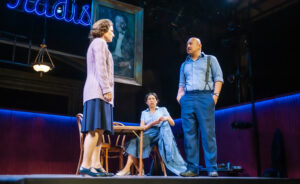
Jeffrey Lo excels to the hilt in his direction of William’s memory play, with breathtaking and illuminating decisions demonstrated throughout. The three key characters of Tom’s memories both participate ‘on stage’ and observe seated on the sidelines the unfolding of his memories. When one or another is the focus of a conversation of others, that ‘memory’ sometimes moves forward from the shadowed side to the stage’s edge in order to hear and see more closely what is happening – often grimacing, smiling, or shaking a head as a reaction. Tom himself occasionally moves physically out of a remembered scene with his family, coming forward to the stage’s edge while continuing his part of the ongoing dialogue, with other characters acting as if he were still present in their midst – all like dreamy interplays of a mind’s wanderings through past events.
The small, sparsely adorned apartment where Tom lives with his mother and sister is in frequent, circular motion on a stage’s large turntable, further illustrating the memories that evidently twirl about in his head and denoting the life of Tom that moves from one day to the next without going anywhere new. The turntable effect is a great collaboration between director and scenic designer, Christopher Fitzer.
Even the initial torn pages that Tom gives to each of the others from his book seem to be a director’s hint of the future memories Tom is leaving for his mother and sister to someday read and recall, for he – like the playwright was once himself– is a poet who also appears near suffocating inside the walls of his family’s apartment and who is determined soon to escape forever its confines.
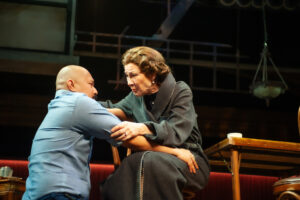
Jomar Tagatac is no less than stunning and stellar as the stage-roaming Tom, lost in memories that pull at emotions expressed in profound manners. Tom tells us, “I seem dreamy but I’m boiling inside;” and we readily see that tension in eyes that are stony one moment and welling in near tears in another. Jomar Tagatac’s Tom sometimes jumps out of a scene and off the raised stage on its turntable with the looks of a trapped animal, only to pace back and forth in near panic or to collapse in apparent desperation up against the stage’s platform.
At heart an aspiring poet, Tom works in a shoe warehouse for a mere $65 a month; and he clearly feels obligation to support his father-less family even though he is restless to move on. His memories fail to edit the moments when the tensions inside erupt into outward shouting matches with his oft-nagging mother. Often after a verbal row with his mother, he escapes to the world of movies where he surrounds himself in newsreels, cartoons, and current blockbusters as he also plots a plan for a more permanent escape to shores and cities far away from St. Louis, even seeing the possibility of an upcoming war in Europe as a welcomed door to open for him a new life. Through it all, this is a Tom whose memories tear at both his and our hearts.
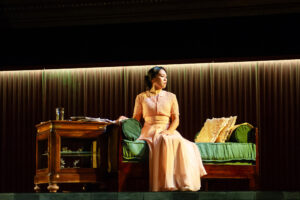
Tom seems most present and content inside the apartment when he is alone with his older sister, Laura. Unlike her brother who grabs every chance possible to leave the apartment, Laura never wants to absent herself from its protection from a world where she feels an outsider. Laura suffers a severe limp from an earlier bout with pleurisy; and even more debilitating, she is almost paralyzed by her extreme shyness. Her escape mechanism is quite opposite from Tom’s. She sits for much of the day in a corner of the apartment where she listens to records on a vintage player and attends to her collection of small, crystal animals, of which a delicate unicorn is her special companion.
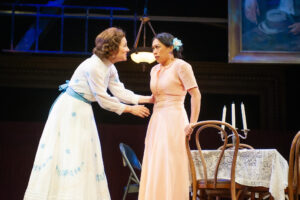
With hands so often tightly clutched they appear ready to break, with ever so slight shudders that shake throughout her, and with eyes that remain for minutes at a time frozen in their downward gaze toward the floor, Nicole Javier’s Laura is visibly plagued in her constant fear of having to expose her limp and her shyness to anyone outside her mother and her brother. At her mother’s yet-again suggestion of receiving a gentleman caller in hopes of finding the twenty-three-year-old recluse a possible husband, her Laura retreats to a couch’s arm, grabbing it, rocking back and forth, and looking as if she could faint or vomit at any moment. Nicole Javier leaves searing images in our mind’s eye – and clearly in Tom’s memory bank – of a young woman in near terror of being anywhere too far from her collections of vintage records or tiny, glass animals, the latter encased in a cabinet as she herself wants to be protected encased the small apartment.
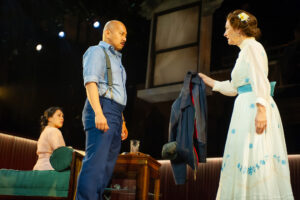
“Both my children are unusual,” Amanda at one point confides to whomever is listening, both of whom she continually has high hopes and makes constant demands that are beyond what either is wanting or even capable of fulfilling. Amanda exists in her own world of memories of when she lived a more comfortable life as a southern belle of sorts in Blue Mountain, Mississippi. She often recounts how there she was often surrounded in her family’s parlor – at least in her memory’s version – by a host of handsome “gentleman callers,” all wanting to secure her undivided attention. When she recalls those days, Susi Damilano as Amanda flutters about giddy and gay like the young girl she would so like still to be, half dancing in moves she waltzed in her more glorious past.
Amanda is worried about a son who seems too content with his warehouse job instead of seeking ways to advance himself and even more concerned by his nightly absences, with her fearing he is not at the movies but in bars living the life as a drunkard. For her daughter, she imagines almost daily that this is the day a gentleman caller will finally come, prodding with her Southern la-di-dah voice the timid, mostly silent Laura to remain “fresh and pretty” for that elusive, sure-to-arrive-any-minute visitor.
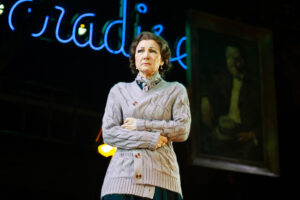
When neither child takes her suggestions for their improvements seriously, the southern-bred charm of Amanda often transforms into an erupting storm of outraged disappointment, with a table pounded in fury, a voice screeching its frustrated anger, or a grand stomping out of the room with threats never to speak again to the current child once again disappointing her. In scene after scene of Tom’s memories of his mother, Susi Damilano employs a plethora of voice manipulations, volumes, and pacing of phrases to embellish the eccentricity of an Amanda who for Tom is remembered as both queen mother and as near monster.
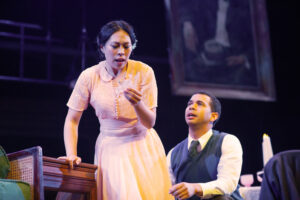
To appease his mother’s constant pleas as well as to seek her forgiveness for his own moments of fury, Tom finally agrees to grant her wish of inviting a co-worker to dinner. Jim O’Connor walks innocently into a trap set by Amanda where the silver has been polished, table linens ironed, and Laura has been forced to don a frilly dress with flower in her hair in her mother’s hope that she lures to the altar that very night her first-ever gentleman caller. When Laura discovers that Jim is a boy she knew in high school and with whom she has ever since had a secret crush, she panics and heads straight to curl up on the couch. As Jim, William Thomas Hodgson is an easy-going and genial guest who is politely amused when Amanda herself transforms into a coquettish, flirting host. With natural charm, his Jim finds a way to ease Laura’s nerves and even to bring out the girl in her she herself hardly recognizes.
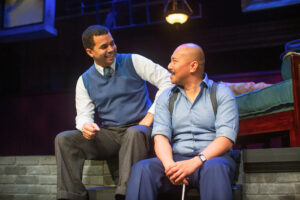
Another powerful set of a director’s deft decisions plays out in the telling looks Tom exchanges all evening with a side-lined Jim who only appears onstage in the second act. That Tom is attracted to Jim is evident in many ways, subtle and not-so-subtle. Tom’s memories – as reenacted through a director’s and an actor’s joint skills – are probably not unlike those of the gay playwright himself.
The flood of Tom’s memories comes even more to life through the powerfully conceived and eye-poppingly executed lighting design by Wen-Ling Liao. Events like a jarring memory of an emotional eruption between family members or of a visitor’s surprise announcement is often highlighted by a stage’s sweeping change of lighting. Spots focus more sharply on a moment remembered or shift our attention from from one scene in progress to a now reflecting and secluded Tom.
Music also plays a big part in recreating the moods and feelings wrapped in Tom’s memories. Swing and jazzy tunes composed by sound designer James Ard bring the pre-war years back to reality while sustained, deep-noted chords full of forebode introduce scenes where memories are to take a possible shift to the darker side.
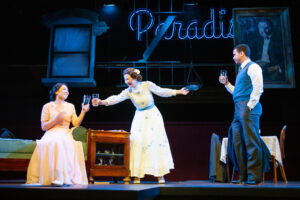
A fifth character dominant but never physically present is the long-absent husband and father whose face-distorted, eye-piercing portrait hangs high above. Partially blocked but clearly visible is a near-by night club’s neon sign displaying the word “Paradise,” Tennessee Williams’ and scenic designer Christopher Fitzer’s combined ironic inclusion of a setting and a home that is the farthest in Tom’s memory from that of a paradise.
But even in memories difficult, sad, and remorseful, there are often many moments of happiness, fondness, and laughter – especially when those memories are of family. The truly beauty of Tennessee Williams’ script and of San Francisco Playhouse’s production is that we as audience time and again smile and laugh aloud as Tom recalls his oft-pained memories – not unlike probably some of our own memories of certain family dynamics we both cherish and otherwise try to forget. In the end, SF Playhouse’s The Glass Menagerie is a director’s, cast’s, and creative team’s masterful recreation of a playwright’s recalled past that will long be remembered by us as a departing audience.
Rating: 5 E, MUST-SEE
A Theatre Eddys Best Bet Production
The Glass Menagerie continues through June 15, 2024, in a two-hour, thirty-minute (with intermission) production by San Francisco Playhouse 450 Post Street, San Francisco. Tickets are available at www.sfplayhouse.org or by calling the box office at 415-677-9596 Monday – Friday, 1:00 – 6:00 p.m.
Photo Credits: Jessica Palopoli
